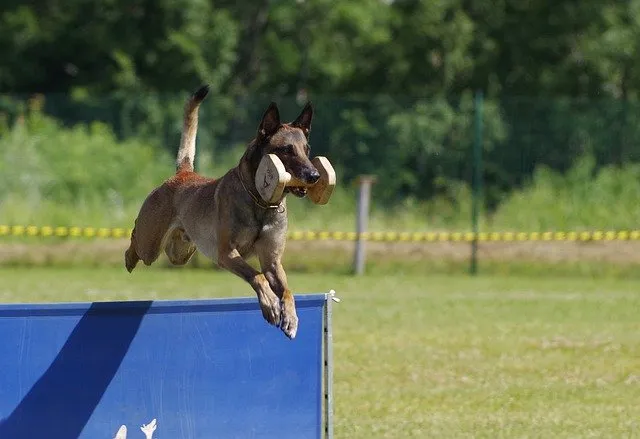As an Amazon Associate I earn from qualifying purchases.
If you’re a proud owner of a Belgian Malinois or considering welcoming one into your home, you might wonder, “What do Belgian Malinois eat?” A well-balanced diet is crucial for maintaining the health, energy, and vitality of this remarkable breed known for its intelligence and athleticism. In this comprehensive blog post, we’re here to answer that question and delve into what makes a nutritionally sound meal for your Belgian Malinois. From high-quality dog food to the role of lean proteins, fruits, and vegetables, we’ll guide you through the dietary choices that can help ensure a long and happy life for your beloved four-legged companion.
What Do Belgian Malinois Eat?
Belgian Malinois, known for their intelligence, agility, and loyalty, are a popular choice among dog owners. A balanced and nutritious diet is essential for the well-being and longevity of your dog. Give them the best chance at a long and healthy life by ensuring they receive the proper nourishment. In this blog post, we’ll explore what Belgian Malinois should eat and explain each food in detail to help you make the best dietary choices for your furry friend.
1. High-Quality Dog Food:
Start with high-quality commercial dog food specifically designed for active and working breeds. Look for options that list meat as the primary ingredient, and avoid those with excessive fillers like corn and wheat. Brands like Royal Canin, Hill’s Science Diet, and Orijen offer suitable choices for Belgian Malinois.
2. Lean Protein:
Proteins are vital for muscle development and overall health. Opt for lean sources like chicken, turkey, beef, or fish. These proteins should make up a significant portion of your dog’s diet. Always ensure the meat is cooked thoroughly and free from bones or additives.
3. Fruits and Vegetables:
Feeding various fruits and vegetables is important for obtaining the essential vitamins, minerals, and fiber that dogs need. Incorporate a variety of options such as sweet potatoes, carrots, blueberries, and apples. These can be given as treats or added to their meals. Avoid feeding grapes, onions, and garlic, as they can harm dogs.
4. Whole Grains:
Whole grains like brown rice and oatmeal can be a valuable source of carbohydrates and fiber. They help provide energy and maintain a healthy digestive system. Be sure to cook grains thoroughly and introduce them gradually to avoid stomach upset.
5. Supplements:
Consult your veterinarian about appropriate supplements for your Belgian Malinois. Common supplements may include fish oil for a healthy coat and joint health, as well as calcium for bone strength. Ensure you’re using supplements recommended by a professional.
6. Eggs:
Eggs are a fantastic source of protein and other essential nutrients. They can be fed scrambled, boiled, or raw (if your vet approves). Remember to serve them without seasoning or spices.
6. Dairy Products (in moderation):
While dairy products can be a part of your Malinois diet, not all dogs tolerate lactose well. If your dog doesn’t show lactose intolerance, you can offer small amounts of plain yogurt or cheese as an occasional treat.
7. Avoid Harmful Foods:
Belgian Malinois should never consume certain foods, including chocolate, caffeine, alcohol, grapes, raisins, onions, garlic, and bones. These items can be toxic or pose choking hazards to your dog.
How do you feed your Belgian Malinois?
Feeding your Belgian Malinois involves several key considerations, including portion sizes, food selection, and mealtime routines. Here’s a detailed guide on how to feed your Belgian Malinois:
1. Choose the Right Dog Food:
Start by selecting a high-quality commercial dog food appropriate for Belgian Malinois. Look for brands that list meat as the primary ingredient and are formulated for active breeds. You can choose between dry kibble, canned food, or a combination of both, depending on your dog’s preferences and specific dietary needs.
2. Portion Control:
Portion control is crucial to ensure your Belgian Malinois receives the right food. The recommended portion size can vary depending on your dog’s age, weight, activity level, and overall health. It’s best to consult with your veterinarian to determine the appropriate daily portion for your specific dog. Many dog food brands provide feeding guidelines on their packaging, but these are often rough estimates. Your vet can offer more precise recommendations to avoid overfeeding (which can lead to obesity) or underfeeding (resulting in nutritional deficiencies).
3. Meal Timing:
Establish a consistent feeding schedule for your Belgian Malinois. Most dogs do well with two meals daily, one in the morning and one in the evening. Consistency in meal timing helps regulate their metabolism and maintains their digestive system in good working order. Avoid leaving food out for your dog to graze on throughout the day. Set specific meal times and remove uneaten food after 15-20 minutes to prevent spoilage and overeating.
4. Use Elevated Food Bowls:
Consider using elevated food and water bowls for your Belgian Malinois. Raised bowls can promote better digestion and reduce the risk of conditions like bloat, which can be more common in deep-chested breeds like the Belgian Malinois.
5. Monitor Your Dog’s Weight:
Keep a close eye on your dog’s weight and body condition. If you notice significant changes in their weight, consult with your veterinarian to adjust their portion sizes accordingly. Belgian Malinois are active dogs, and their dietary needs can change over time.
6. Treats and Snacks:
Use treats and snacks in moderation. It’s important to factor in the calories from treats when determining your dog’s daily food allowance. During training, choose healthy, dog-friendly treats or use bits of their regular kibble as rewards.
7. Fresh Water:
Always provide your Belgian Malinois with access to fresh, clean water. Proper hydration is essential for their overall health.
8. Dietary Adjustments:
As your Belgian Malinois ages or if they develop specific health concerns, their dietary needs may change. Consult with your vet for guidance on modifying their diet as necessary.
When to feed you Belgian Malinois?
Feeding your Belgian Malinois at the right times is crucial for their health and well-being. A consistent feeding schedule helps regulate their metabolism, maintain their digestive system, and structure their day. Here’s a detailed explanation of when to feed your Belgian Malinois:
Puppy Stage (6-12 Weeks):
During the early puppy stage, Belgian Malinois require frequent feeding to support their growth and development. Here’s a typical schedule:
3 to 4 Meals Per Day: Puppies of this age generally do well with three to four small daily meals. This schedule helps maintain their energy levels and accommodates their small stomach capacity. Ensure that the total daily portion is divided into these multiple meals.
Evenly Spaced Meals: Space out the meals evenly throughout the day to ensure they receive a constant source of nutrition. Puppies have high energy requirements, and regular meals help meet those needs.
Gradual Transition: As your puppy grows and their stomach capacity increases, you can gradually reduce the number of meals and increase the portion size per meal. By the time they reach three to six months of age, you can transition to two meals a day.
Adolescent and Adult Stage (6 Months and Older):
2 Meals Per Day: For adolescent and adult Belgian Malinois, two meals per day are typically sufficient. One meal in the morning and one in the evening is a common schedule.
Consistent Timing: Establish a regular feeding schedule, with meals at the same times each day. Consistency helps regulate their body’s internal clock, making it easier for them to anticipate meals.
Portion Control: Ensure portion sizes align with your dog’s dietary needs. Consult with your veterinarian to determine the appropriate daily portion to maintain your ideal body weight and energy level.
Avoid Free Feeding: It is highly recommended to avoid leaving food out all day for your dog to ensure optimal health. This practice can lead to overeating and make it difficult to regulate their diet. Instead, you can provide your canine companion with regular meals at designated times, allowing for better control over their dietary intake.
Senior Stage (7-8 Years and Older):
Adjusted Diet: As your Belgian Malinois enters the senior stage, their activity level may decrease, and their metabolism may slow down. Adjust their diet accordingly by potentially reducing portion sizes and considering senior dog food formulas.
Regular Meals: Maintain the two-meal-a-day schedule, but be more attuned to your senior dog’s needs. Consult with your veterinarian for guidance on appropriate dietary adjustments.
The timing of feeding your Belgian Malinois is an essential part of their daily routine. A consistent schedule that aligns with your dog’s age, activity level, and dietary requirements helps maintain their overall health and well-being. Regular and balanced meals ensure they receive the necessary nutrients and energy for their daily activities, whether puppies, adolescents, adults, or seniors.
Final Words
Feeding your Belgian Malinois a well-balanced diet is essential for their health and happiness. A diet consisting of high-quality dog food, lean protein, fruits, vegetables, whole grains, and appropriate supplements will help your dog thrive. Remember to consult with your veterinarian to create a customized nutrition plan for your Belgian Malinois, considering their age, activity level, and specific dietary requirements. By following these guidelines and providing the right foods, you’ll ensure your beloved Malinois enjoys a long and healthy life.
You can also read:
1.What Do Teacup Puppies Eat? From Bowl to Bliss
2.What do Alaskan Malamutes eat? A Balanced Diet for Alaskan Malamutes
3.What Do Birman Cats Eat? Exploring Birman Cat Cuisine
4.What Do Cavapoo Puppies Eat? A Guide to Their Nutritional Needs
Amazon and the Amazon logo are trademarks of Amazon.com, Inc, or its affiliates.



